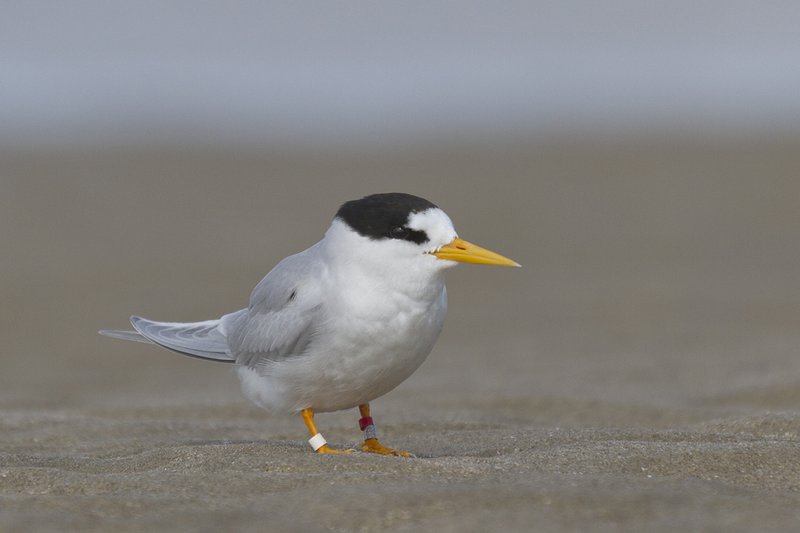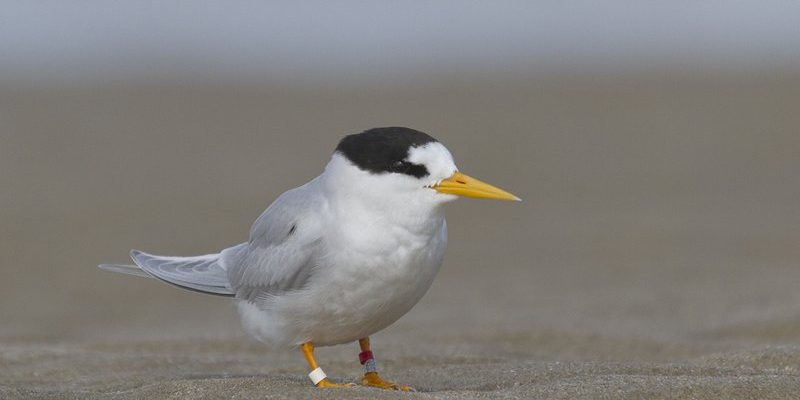
Imagine you’re strolling along a peaceful beach, the waves gently lapping at the shore. Suddenly, you spot a small, elegant bird with a striking white body and soft gray wings darting gracefully through the air. This lovely creature is the Fairy Tern, also known as the white tern. With its delicate appearance and charming behaviors, it captures the hearts of birdwatchers and nature enthusiasts alike.
The Fairy Tern is not just a pretty face; it plays a vital role in its coastal habitat. These birds are known to inhabit some of the most stunning tropical and subtropical areas around the world. Their presence adds a touch of magic to the ecosystems where they thrive. In this article, we’ll explore the Fairy Tern’s characteristics, behaviors, habitat, and much more. So, let’s dive into the enchanting life of this beautiful bird!
Physical Characteristics
The Fairy Tern is a small seabird, typically measuring around 25 to 30 centimeters in length. One of its most striking features is its pure white plumage, which contrasts beautifully with its gray wings and tail. This coloration not only makes the Fairy Tern look stunning against the blue sky and ocean but also aids in camouflage when it’s high in the skies. Its slender body is perfectly adapted for aerial fishing, allowing it to swoop gracefully down to catch its prey.
In addition to its vibrant coloring, Fairy Terns are also recognized for their long, pointed wings and a distinctive forked tail. This tail design helps them maneuver quickly in the air, making them agile hunters. Its small size makes it easy for them to evade larger predators, while their speed allows them to travel between feeding and breeding grounds rather efficiently. With that said, the Fairy Tern is not just a vision of beauty; its physical traits serve crucial functions in its survival.
Habitat and Distribution
Fairy Terns prefer coastal environments, often found on sandy beaches, rocky shorelines, and small islands. Their preferred nesting sites are generally *uninhabited* and away from heavy human activity, which helps protect their eggs and chicks from predators. These birds are typically found in tropical and subtropical regions, including the South Pacific islands and parts of Southeast Asia. Some populations even migrate seasonally to find optimal breeding and feeding locations.
During the breeding season, which varies by region, Fairy Terns build their nests on the ground among the sand and pebbles. This strategy provides safety but also poses risks, as the nests are vulnerable to tides and floods. Despite these challenges, these resilient birds have adapted well to their environments. Their ability to thrive in such diverse coastal settings is a testament to their evolutionary success.
Diet and Feeding Habits
The Fairy Tern is primarily a piscivore, meaning they mostly feed on fish. Their diet mainly consists of small fish, crustaceans, and marine invertebrates. What’s fascinating is their hunting technique. They often hunt by hovering above the water before diving down to catch their prey in a swift motion. It’s like watching a tiny acrobat perform aerial stunts! This method ensures they are not just efficient hunters but also entertaining to observe.
In addition to fish, Fairy Terns may also forage for food on the water’s surface. They look for schools of fish and might even dive or plunge into the water to catch their meal. Their excellent eyesight helps them spot prey from great heights, enhancing their success rate while hunting. With their specialized feeding behaviors, these birds are well adapted to make the most of the resources available in their coastal habitats.
Behavior and Social Structure
Fairy Terns are social birds, often seen in flocks, especially during feeding and migration. Their social interactions include a range of vocalizations and displays, which help strengthen their bonds. During breeding season, you might notice courtship displays, where males show off their agile flying abilities to impress potential mates. This aerial ballet adds a layer of charm to their already enchanting behavior.
When it comes to parenting, Fairy Terns exhibit strong protective instincts. Both parents participate in raising the chicks, providing them with food and ensuring their safety. They often take turns watching over the nest while the other hunts. This cooperative behavior enhances the chicks’ chances of survival and highlights the strong family bonds within these small birds.
Conservation Status
While Fairy Terns are not currently listed as endangered, their populations face several threats. Habitat loss due to coastal development and human activities can significantly impact their nesting sites. Additionally, environmental changes, such as rising sea levels from climate change, threaten their fragile coastal habitats. Conservation efforts focus on protecting these essential areas and raising awareness about the importance of preserving their ecosystems.
Organizations and wildlife agencies are actively working to monitor Fairy Tern populations and implement protective measures. Creating awareness among local communities is also vital as it encourages sustainable practices to lessen human impact on their habitats. By working together, we can help ensure that these beautiful birds continue to grace our coastlines for generations to come.
Interesting Facts About Fairy Tern
| Size: | 25-30 cm (10-12 in) |
| Wingspan: | 60-70 cm (24-28 in) |
| Diet: | Mainly small fish and marine invertebrates |
| Breeding Season: | Varies by region; typically between April and September |
| Lifespan: | Up to 15 years in the wild |
| Distribution: | Tropical and subtropical coastal regions, South Pacific, Southeast Asia |
The Fairy Tern is more than just a beautiful bird; it’s a symbol of resilience and the delicate balance of coastal ecosystems. With its charming appearance and fascinating behaviors, it reminds us of the wonders of nature. By understanding its habitat, diet, and social structure, we can appreciate the rich tapestry of life that exists around us. Whether you’re a birdwatcher or simply a lover of nature, the Fairy Tern is a bird that leaves a lasting impression.
FAQ
What is the main diet of the Fairy Tern?
The Fairy Tern primarily feeds on small fish, crustaceans, and marine invertebrates. They are skilled hunters, often hovering above the water before diving to catch their prey. This technique allows them to maximize their hunting efficiency while providing them with the nutrients they need to thrive.
How do Fairy Terns build their nests?
Fairy Terns typically build their nests on sandy beaches or rocky shores, choosing secluded areas to reduce the risk of predation. They often scrape out a small depression in the sand and may line it with pebbles or other debris. This simple yet effective nesting strategy helps protect their eggs and young chicks during the vulnerable breeding season.
Are Fairy Terns social birds?
Yes, Fairy Terns are quite social! They often gather in flocks, especially during feeding and migration. Their social interactions include various vocalizations and displays, which strengthen their bonds within the group. During breeding season, males perform impressive aerial displays to attract females, showcasing their agility and charm.
What threats do Fairy Terns face?
While they are not currently endangered, Fairy Terns face threats such as habitat loss due to coastal development and environmental changes from climate change. Rising sea levels and increased human activity can affect their nesting sites and overall populations. Conservation efforts are important to help protect these birds and their habitats.
Where can you find Fairy Terns?
Fairy Terns are typically found along tropical and subtropical coastlines, particularly in the South Pacific and parts of Southeast Asia. They prefer sandy beaches and small islands that are relatively uninhabited, providing safe nesting sites away from human activity. Observing these lovely birds is often best done in their natural habitats.
What does the Fairy Tern’s call sound like?
The Fairy Tern has a variety of calls that can range from soft whistles to sharp, high-pitched notes. These vocalizations are used in social interactions, especially during breeding season when establishing territory or attracting mates. Listening to their calls can add another layer of enjoyment when observing these charming birds in the wild.
How long do Fairy Terns live?
Fairy Terns can live up to 15 years in the wild. The longevity of these beautiful birds depends on various factors, including food availability and environmental conditions. By protecting their habitats and ensuring a stable food supply, we can help these charming birds flourish in their natural environments.
What makes the Fairy Tern unique among seabirds?
What truly sets the Fairy Tern apart is its striking appearance combined with its charismatic hunting behaviors. Its graceful flying skills and social dynamics make them fascinating to observe. Additionally, their ability to adapt to diverse coastal habitats and collaborate in raising their young highlights the intricate relationships that exist within their ecosystems.
How can I help protect Fairy Terns?
You can help protect Fairy Terns by supporting local conservation efforts focused on preserving coastal habitats. Educating others about the importance of these birds and their ecosystems is vital. Additionally, practicing responsible eco-tourism—such as avoiding disturbing nesting areas—is crucial in ensuring these lovely birds continue to thrive.
What is the breeding season of the Fairy Tern?
The breeding season for Fairy Terns varies by region, but it typically occurs between April and September. During this time, they engage in courtship displays and build nests to raise their young. Understanding their breeding habits helps in monitoring their populations and ensuring effective conservation strategies are implemented.
Can Fairy Terns be found in captivity?
Fairy Terns are primarily wild birds and are not typically kept in captivity. They thrive best in their natural habitats, where they can hunt, breed, and socialize with other terns. Captivity can hinder their natural behaviors and disrupt their social structures, making conservation of their environment a more effective approach.

